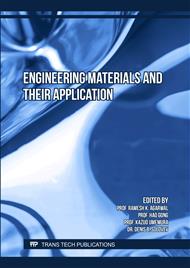[1]
P. Gao, R. Cha, H. Luo, Y. Xu, P. Zhang, L. Han, X. Wang, Z. Zhang and X. Jiang: Carbohydrate Polymers Vol. 278 (2022), p.118922
DOI: 10.1016/j.carbpol.2021.118922
Google Scholar
[2]
W.S. Lim, S.Y. Ock, G.D. Park, I.W. Lee, M.H. Lee and H.J. Park: Food Packaging and Shelf Life Vol. 26 (2020), p.100556
DOI: 10.1016/j.fpsl.2020.100556
Google Scholar
[3]
J. Zhou, J. Tong, X. Su, and L.Ren: International journal of biological macromolecules Vol. 91 (2016), pp.1186-1193
Google Scholar
[4]
M. Chiumarelli, L.M. Pereira, C.C. Ferrari, C.I. Sarantópoulos and M.D. Hubinger: Journal of Food Science Vol. 75 No.5 (2010), pp.E297-E304
DOI: 10.1111/j.1750-3841.2010.01636.x
Google Scholar
[5]
A. Golachowski, W. Drożdż, M. Golachowska, M. Kapelko-Żeberska, and B. Raszewski: Foods Vol. 9 No.9 (2020), p.1311
DOI: 10.3390/foods9091311
Google Scholar
[6]
P. G. Seligra, C. M. Jaramillo, L. Famá, and S. Goyanes: Carbohydrate Polymers Vol. 138 (2016), pp.66-74
DOI: 10.1016/j.carbpol.2015.11.041
Google Scholar
[7]
N. Reddy and Y. Yang: Food chemistry Vol. 118 No.3 (2010), pp.702-711
Google Scholar
[8]
W. T. Owi, H. L. Ong, S. T. Sam, C. K. Tsai, and H. M Akil: Industrial Crops and Products Vol. 139 (2019), p.111548
DOI: 10.1016/j.indcrop.2019.111548
Google Scholar
[9]
Q. Ma, L. Du, and L. Wang: Sensors and Actuators B: Chemical Vol. 244 (2017), pp.759-766
Google Scholar
[10]
M.M. Hassan, N. Tucker, and M.J. Le Guen: Carbohydrate Polymers Vol. 230 (2020), p.115675
Google Scholar
[11]
P. Utomo, N.M. Nizardo and E. Saepudin: AIP Conference Proceedings Vol. 2242 No.1 (2020), p.040055
Google Scholar
[12]
Z.Y. Ben, H. Samsudin and M.F. Yhaya: European Polymer Journal (2022), p.111377
Google Scholar
[13]
P.S. Garcia, M.V.E. Grossmann, F. Yamashita, S. Mali, L.H. Dall'Antonia and W.J. Barreto: Química Nova Vol. 34 (2011), pp.1507-1510
DOI: 10.1590/s0100-40422011000900005
Google Scholar
[14]
B. Ghanbarzadeh, H. Almasi, and A. A. Entezami: Industrial Crops and products Vol. 33 No.1 (2011), pp.229-235
Google Scholar
[15]
R. Shi, J. Bi, Z. Zhang, A. Zhu, D. Chen, X. Zhou, L. Zhang and W. Tian: Carbohydrate Polymers Vol. 74 No.4 (2008), pp.763-770.
Google Scholar



